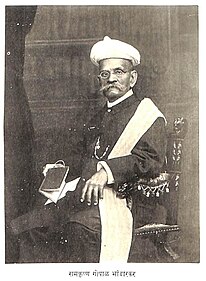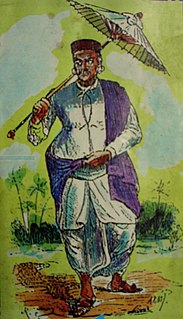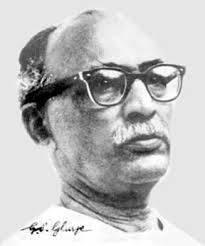Related Research Articles
Jāti is a group of clans, tribes, communities, and sub-communities, and religions in India. Each Jāti typically has an association with a traditional job function or tribe. Religious beliefs or linguistic groupings may define some Jātis.
Shudra or Shoodra is the lowest ranked of the four varnas of the Hindu caste system and social order in India. Various sources translate it into English as a caste, or alternatively as a social class.
Marathi literature is the body of literature of Marathi, an Indo-Aryan language spoken mainly in the Indian state of Maharashtra and written in the Devanagari and Modi script.
Deshastha Brahmins are a Hindu Brahmin subcaste mainly from the Indian state of Maharashtra and northern area of the state of Karnataka. Other than these two states, according to authors K. S. Singh, Gregory Naik and Pran Nath Chopra, Deshastha Brahmins are also concentrated in the states of Andhra Pradesh and Telangana. Author Pran Nath Chopra and journalist Pritish Nandy says, "Most of the well-known saints from Maharashtra, Karnataka and Andhra Pradesh were Deshastha Brahmins".
Karhaḍe Brahmins are a Hindu Brahmin sub-caste mainly from the Indian state of Maharashtra.
Chandraseniya Kayastha Prabhu (CKP) is an ethno-religious caste of South Asia. Traditionally, the CKPs have the upanayana and have been granted the rights to study the vedas and perform vedic rituals along with the Brahmins. Ritually ranked very high, they may be considered socially proximate to the Maharashtrian Brahmin community. They have traditionally been an elite and literate but a numerically small community.
The Marathi people, also rendered as Marathis or Maharashtrian, are an ethnolinguistic group who speak Marathi, an Indo-Aryan language as their native language. They inhabit the state of Maharashtra as well as districts bordering the state, such as Belgaum of Karnataka and the state of Goa in western India as well as districts of southern Gujarat and parts of Madhya Pradesh. The term 'Maratha' is generally used by historians to refer to all Marathi-speaking peoples, irrespective of caste. At present, however, it refers to a set of Maharashtrian castes called Maratha. The Marathi community came into political prominence in the 17th century when the Marathas, under Shivaji Maharaj, established the Maratha Empire, which is credited to a large extent for ending the Mughal rule.

Sir Ramakrishna Gopal Bhandarkar was an Indian scholar, orientalist, and social reformer.

The caste system in India is the paradigmatic ethnographic example of caste. It has origins in ancient India, and was transformed by various ruling elites in medieval, early-modern, and modern India, especially the Mughal Empire and the British Raj. It is today the basis of affirmative action programmes in India. The caste system consists of two different concepts, varna and jati, which may be regarded as different levels of analysis of this system.

The Daivadnya Brahmins are a Konkani people and a subgroup of the Hindu Brahmin castes native to the Konkan, predominantly residing in Goa and Damaon, Canara, coastal Maharashtra, and Kerala.
Idangai or the left hand is a caste-based division of communities in Tamil Nadu that was in vogue from ancient times right up to the 19th and even the early decades of the 20th century AD. Since India's independence, the differences have practically vanished. The corresponding division is Valangai.
Valangai or the right hand refers to a caste-based division of communities in the Indian state of Tamil Nadu that was in vogue from ancient times right up to the 19th and even the early decades of the 20th century AD. Since India's independence, the differences have practically vanished.

The Mali are an occupational caste found among the Hindus who traditionally worked as gardeners and florists. They also call themselves Phul Mali due to their occupation of growing flowers. The Mali are found throughout North India, East India as well as the Terai region of Nepal and Maharashtra.

Yadav refers to a grouping of traditionally mainly non-elite, peasant-pastoral communities or castes in India that since the 19th and 20th centuries have claimed descent from the mythological king Yadu as a part of a movement of social and political resurgence.
Marathi Brahmins are communities native to the Indian state of Maharashtra. They are classified into five sub-divisions based on their places of origin, "Desh", "Karad" and "Konkan". Together, these divisions comprise members of various gotras, being the Deshastha, Kokanastha, Saraswat, Karhade, Daivajna and Devrukhe.The Kokanastha are also known by the alternative name, Chitpavan.The Deshastha Brahmins are considered the original Brahmins of Maharashtra, with communities such as the Chitpavan being thought of as migrants from other areas.

Gavli, Gawli, Gauli or Gaoli is a cattle-herding caste found in the Indian states of Maharashtra, Goa and Karnataka. Gavlis include Ahirs, Gavlans and Gavaris which are considered as synonymous names. They are distributed all over Maharashtra. Gavli as a community refers to either cowherds or sellers of milk and its products or both. Although Enthoven classifies Gavlis into 17 sub-groups, he notes that they have nothing in common except a common occupation. While some of them are sub-castes of distinct castes like Dhangar Gavlis, Golla Gavlis, Kuruba Gavlis and Lingayat Gavlis, others are localized castes of their respective regions. Alongwith Dhangars and Maratha Kunbis, Gavlis are considered one of the allied castes of Maratha caste and have been included in the Maratha Regiment in the past.

The Divine Heritage of the Yadavas is a book by Vithal Krishnaji Khedkar which describes a divine heritage from Krishna for those Hindu communities (Jātis) occupied with herding cattle and selling milk. The book posits that the cattle-keeping castes had become incorrectly ranked as Shudra (labourers) in the varna system for a variety of reasons: their adherence to ritual purity was difficult to verify due to their nomadic lifestyle, they castrated animals, and they sold milk commercially. The scholar David Goodman Mandelbaum describes the work as "combin[ing] a traditional origin myth and a highly modernized improvement campaign."
Raghunath Vithal Khedkar was an Indian surgeon. In 1959, he revised, enlarged, and published a historical work written by his father, Vithal Krishnaji Khedkar: The Divine Heritage of the Yadavas.

Govind Sadashiv Ghurye was an Indian professor of sociology. In 1924, he became the second person to head the Department of Sociology at the University of Bombay.
Anant Viththal Keer, known by his alias Dhananjay Keer (1913–1984) was an Indian biographer who profiled many high profile politicians and social activists. He had written biographies of Bal Gangadhar Tilak, V. D. Savarkar, B. R. Ambedkar, Jyotiba Phule, Rajarshi Shahu Maharaj and Mahatma Gandhi.
References
- 1 2 3 Rao, M. S. A. (1972). Tradition, rationality, and change: essays in sociology of economic development and social change. Popular Prakashan. p. 77.
- ↑ Frykenberg, Robert Eric (1984). Land tenure and peasant in South Asia. Manohar. p. 198.
- ↑ Ghurye, G. S. (2008). Caste and race in India. Popular Prakashan. p. 451. ISBN 978-81-7154-205-5.
- ↑ Ghurye, G. S. (1969). Caste and race in India . Popular Prakashan. p. 450.
The All-India Yadav Mahasabha owes its origin to the nineteenth century work of one VK Khedkar, a member of the Maharashtrian caste, known as Gowli, of Ratnagiri district
- ↑ Mandlbaum, David Goodman (1970). Society in India: Change and continuity. University of California Press. p. 442. ISBN 978-0-520-01623-1.
- ↑ Jaffrelot, Christophe (2003). India's silent revolution: the rise of the lower castes in North India. Columbia University Press. p. 163. ISBN 978-0-231-12786-8.